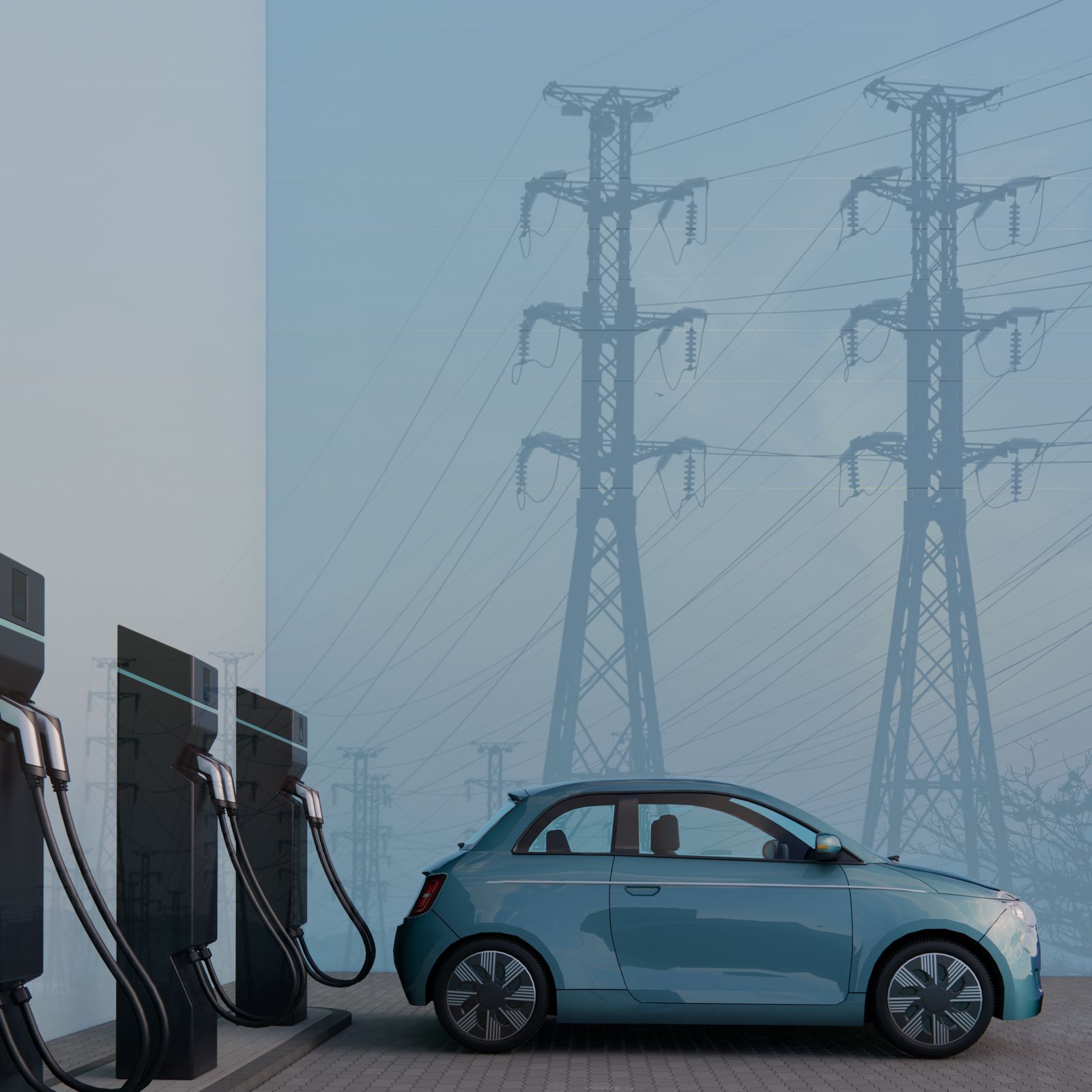
Authors: Natalie Alechko, Jenifer Bustamante, Katie Farrell, and Annika McGraw
Edited By: Muhammad Hani Ahsan
Graphic By: Norie Wright and Arsh Naseer
Research Question: How will electric vehicle (EV) charging stations be deployed and made sustainable, following ESG criteria?
Introduction
Electric vehicles are defined as “vehicles that can be powered by an electric motor that draws electricity from a battery and is capable of being charged from an external source” [1]. Their popularity has seen increases and decreases since their first inception over one hundred years ago [2]. The implementation and accessibility of electric vehicles and their charging stations have increased due to regulations from local, state, and federal governments, which work with private distributors to encourage purchases of electric vehicles and storefronts to adopt charging stations. This way of thinking from the private, public, and government sectors is known as Environmental, Social, and Governance (ESG), which motivates businesses to consider environmental, social, and corporate governance issues when making business decisions. Specific ESG considerations in the implementation of electric vehicles include economic and equity costs. Overall, as electric vehicles expand their availability from the elite and wealthy to the average everyday citizen, there will be more of a necessity from government and private organizations alike to collaborate on policies that will keep up with the rapid demand.
Historical Background of Policy
The history of electric vehicles (EVs) has been marked by fluctuating popularity since their first appearance in the late 19th century. Initially introduced in 1890 by William Morrison, the first EV was essentially an electric carriage capable of holding six people and reaching speeds of fourteen miles per hour, presenting a quiet and convenient alternative to the steam and gasoline-powered vehicles of the time [3]. Despite electric vehicles constituting over one-third of all vehicles on the road by 1900, their prevalence significantly declined following the mass production of Henry Ford’s Model T.
Interest in EVs resurged in response to the oil embargoes of the 1960s and 1970s, leading to increased gas prices and sparking a renewed focus on alternative transportation methods. This period also saw the rise of the modern environmental movement, further propelling the interest in electric vehicles. Legislative actions such as the Electric and Hybrid Vehicle Research, Development, and Demonstration Act of 1976 supported this resurgence by funding EV research through the Department of Energy. This practice continues today with initiatives like the American Recovery and Reinvestment Act 2009 [4].
The advent of modern EVs, exemplified by the Toyota Prius and followed by Tesla’s electric sports cars, marked a significant turning point. These vehicles matched the performance of gasoline-powered cars in speed, reliability, and longevity, contributing to the diversification of the EV market. This market now includes hybrid electric vehicles (HEVs), plug-in hybrid electric vehicles (PHEVs), all-electric vehicles, and plug-in electric vehicles (PEVs), each offering different advantages in terms of energy source, environmental impact, and charging convenience. Today, more than fifty plug-in electric and hybrid models provide consumers with a wide range of choices, supporting the growing adoption of EVs [5].
Examination of Available Data and Economic Considerations
Electric Vehicle Adoption Data and Trends
The electric car market has experienced remarkable growth, with sales doubling in 2021 to reach a record of 6.6 million vehicles. From just 120,000 electric cars sold worldwide in 2012, the market has expanded exponentially, and nearly 10% of global car sales in 2021 were electric. China played a significant role in this growth, accounting for half of the total increase, with 3.3 million electric cars sold in the country in 2021 [6].
Various factors contribute to the success of electric vehicles (EVs), including substantial policy support, increased government spending on subsidies (nearly USD 30 billion in 2021), and the commitment of numerous countries to phase out internal combustion engines. The availability of a broader range of EV models has also enhanced consumer attractiveness, with around 450 models in the market [7]. However, challenges loom, particularly in terms of mineral supply constraints. Despite the positive sales trends, much work remains to support charging infrastructure and the electrification of heavy-duty vehicles. Global supply chain disruptions due to events like the COVID-19 pandemic and Russia’s war in Ukraine may impact EV delivery times in the short term [8].
While the International Energy Agency’s (IEA) Announced Pledges Scenario envisions EVs representing over 30% of global vehicle sales in 2030, aligning with a net-zero emissions trajectory by 2050 requires a more ambitious 60% share. Charging infrastructure must expand significantly to meet the growing EV market’s needs, with the global market value of electricity for EV charging projected to reach approximately USD 190 billion by 2030. Electric trucks, a key component of the EV landscape, still face challenges in deployment outside China. Governments and manufacturers are making efforts, with more than 170 electric truck models available globally in 2021. Electric truck sales must reach 25% by 2050 to achieve net-zero ambitions [9].
The electrification of transport brings multiple benefits, including reductions in air pollution, oil demand, and greenhouse gas emissions. EV deployment aligning with the IEA’s Announced Pledges Scenario could displace 1.6 million barrels per day of oil by 2025 and 4.6 million barrels per day by 2030. Despite the challenges, electrifying transport is seen as a significant step toward addressing climate change and achieving a sustainable energy future [10].
Electric Vehicle Charging and Battery Data
The expansion of battery markets driven by the surge in electric vehicle (EV) sales poses challenges to the resilience of battery supply chains. The COVID-19 pandemic’s impact on EV sales and Russia’s war in Ukraine have further intensified the challenge, leading to a notable increase in raw material prices, including cobalt, lithium, and nickel. As of May 2022, lithium prices were over seven times higher than at the beginning of 2021 [11]. Several factors, including unprecedented battery demand, insufficient structural investment in new supply capacity, and geopolitical events affecting key raw material supplies, contribute to the situation. Average battery prices fell by 6% to USD 132 per kilowatt-hour in 2021, a slower decline than the previous year. If metal prices remain high in 2022, battery packs could become 15% more expensive than in 2021 [12].
Current battery supply chains are highly concentrated in China, which produces three-quarters of all lithium-ion batteries and dominates production capacity for key components like cathodes and anodes. Europe and the United States are smaller in the global EV battery supply chain. Despite efforts to develop domestic supply chains, China will likely maintain its dominance through 2030 [13].
In conclusion, while the demand for minerals is expected to increase, factors like innovation, recycling, and technology shifts could play crucial roles in shaping the future of battery supply chains, especially as the world aims to achieve net-zero ambitions and address the challenges posed by the preferences for large electric vehicle models. There are currently almost 50,000 electric vehicle (EV) charging stations in the United States, as listed by the Alternative Fuels Data Centre. Of these, 93% are publicly accessible, and 17% are situated on non-urban roads, including highways and other arterials. The majority of direct current (DC) fast chargers (99%) are public, with 25% located on highways, catering to the faster charging needs at these key locations [14].
Approximately 6% of the charging stations are situated along the interstate highway system, which forms the backbone of the national road network. Stations along these interstates comprise 16% of the total DC fast charging points. About 8% of the U.S. population resides more than 10 kilometers from a public charging station. Reducing this share to less than 5% would require building an additional 1,185 stations, and achieving zero percent would necessitate constructing more than 5,000 additional stations. This information highlights the current state of EV charging infrastructure in the United States and the considerations for improving accessibility to charging stations, particularly for those living farther from existing infrastructure [15].
Information on the Frequency and Duration of Charging Sessions
The frequency and duration of electric vehicle (EV) charging sessions are influenced by factors such as battery capacity, infrastructure availability, driving habits, and commuting needs. Most EV owners prefer charging their vehicles at home overnight to benefit from lower off-peak electricity rates, ensuring a full battery for daily use. Public charging stations are an alternative for on-the-go needs or when home charging is not an option. Charging frequency varies with each driver’s daily mileage, with some needing daily charges, while others charge less frequently depending on commute lengths and access to charging facilities. The charging time ranges from a few hours with standard home chargers to 20-30 minutes at fast public stations, largely depending on the charging method and battery size. Infrastructure availability significantly affects where and when drivers can charge, with well-served areas offering more flexibility. Workplace charging stations further alter charging patterns, allowing for daytime charging. Seasonal changes, especially in colder climates, may necessitate more frequent charging due to decreased battery efficiency.
Emissions and Energy Efficiency Data
Electric vehicles (EVs) are generally considered more environmentally friendly than traditional internal combustion engines regarding greenhouse gas emissions, particularly carbon dioxide (CO2). The comparison involves evaluating emissions throughout the entire life cycle of both types of vehicles, including manufacturing, fuel production, and vehicle operation.
- Zero Tailpipe Emissions: One of the most significant advantages of electric vehicles is that they produce zero tailpipe emissions. During operation, traditional vehicles with internal combustion engines emit pollutants such as CO2, nitrogen oxides (NOx), and particulate matter. In contrast, EVs operate solely on electricity and do not emit any pollutants from the exhaust.
- Energy Source Impact: EVs’ overall environmental impact depends on the electricity source used to charge them. In regions where the electricity grid relies heavily on fossil fuels, the emissions associated with EVs may be higher compared to regions with a higher share of renewable energy sources. However, as the electricity grid transitions to cleaner energy sources, the emissions associated with EVs decrease.
- Improvements in Efficiency: Electric vehicles are generally more energy-efficient than traditional vehicles. They convert a higher percentage of the energy from the power source to movement, resulting in fewer overall energy losses. This efficiency contributes to lower CO2 emissions per mile or kilometer traveled.
Charging Station Usage
Source: [16]
Source: [17]
In 2021, the global expansion of publicly available electric vehicle (EV) charging points continued, despite pandemic-related construction slowdowns. The rise in EV markets highlighted the need for increased access to public charging infrastructure, aligning with consumer expectations for EVs to match the convenience of conventional vehicles. The worldwide count of publicly accessible chargers approached 1.8 million, with approximately one-third being fast chargers. Nearly 500,000 chargers were installed in 2021, surpassing the total number available in 2017. Although the growth rate in 2021 was 37%, it was slightly lower than in 2020 (45%), reflecting a post-pandemic adjustment [18].
China led in the number of publicly available chargers, hosting about 85% of the world’s fast chargers and 55% of slow chargers, showcasing its leadership in the EV sector. Slow charger installations in China increased by 35% in 2021, reaching around 680,000 units. Europe ranked second, with over 300,000 slow chargers, marking a 30% year-on-year increase. The Netherlands, France, Germany, the United Kingdom, Italy, Norway, and Sweden were among the leading European countries in slow charger installations. In the United States, slow chargers increased by 12% to 92,000 in 2021 [19].
Fast chargers, crucial for facilitating longer journeys and addressing range anxiety, experienced accelerated deployment. In China, fast-charging installations increased by over 50% to 470,000 units in 2021. Government subsidies and infrastructure development by public utilities drove this rapid deployment. Europe also saw a 30% increase in public fast chargers, reaching nearly 50,000 units. Notably, the United States had about 22,000 fast chargers, with nearly 60% being Tesla superchargers, and Korea witnessed a 50% growth, totaling 15,000 fast chargers [20].
Equity Considerations
The global rise in electric vehicle (EV) use is influenced by environmental awareness and technological advancements, underscoring the need for extensive EV charging infrastructure development that ensures equitable access across economic, geographical, and technological dimensions [21].
Economic Equity: With EVs expected to constitute 31% of the vehicle market by 2040, adopting equitable pricing strategies like time-of-use rates and rebates is crucial. Time-of-use rates encourage charging during off-peak hours, improving affordability and grid efficiency, while rebates provide financial incentives to lower-income individuals, easing the transition to EV ownership [22].
Geographical Equity: Equitable location selection for charging stations is vital to cover both urban and rural areas comprehensively. This strategy ensures that EV infrastructure reaches diverse communities, including marginalized ones, thereby promoting broader EV adoption and sustainable transportation [23].
Technological Equity: Ensuring that charging stations are compatible with all EV models and accessible to people with disabilities or those requiring multilingual instructions is essential for fostering inclusive use of EV infrastructure [24].
By prioritizing these equity considerations in the deployment of EV charging infrastructure, policymakers and administrators can support a more inclusive and sustainable EV ecosystem.
Moving Forward
The U.S. green transition emphasizes sustainable and eco-friendly advancements, with expanding the electric vehicle (EV) charging network being pivotal. Strategies for equitable EV charging access include urban and rural expansion, leveraging Public-Private Partnerships (PPPs), embracing technological innovations, and adjusting policies and incentives.
Urban strategies should focus on densely populated areas, while rural strategies should ensure broad accessibility, highlighting the importance of a comprehensive network spanning highways to facilitate long-distance EV travel. PPPs offer a collaborative approach to funding and risk-sharing, essential for scaling infrastructure efficiently. Technological advancements, driven by research from various sectors, are critical for addressing energy challenges and improving sustainability. Regulatory support, including incentives for manufacturers and consumers, plays a crucial role in encouraging EV adoption and infrastructure development.
Conclusion
Addressing the question of sustainable EV charging station deployment necessitates a multifaceted strategy. Informed decision-making, backed by data on infrastructure demand, technological progress, and consumer trends, is essential. Policies fostering inclusivity and accessibility are vital for a just transition to sustainable transportation, with governmental cooperation at all levels ensuring cohesive policy frameworks. Addressing potential risks and embracing ESG principles are key to a resilient and equitable infrastructure network, aligning national efforts with climate change mitigation, social equity, and governance integrity.
References
[1] Department of Energy. n.d. “Electric Vehicle (EV) Definition.” Alternative Fuels Data Center. Accessed [Date]. https://afdc.energy.gov/laws/12660.
[2] Department of Energy. n.d. “The History of the Electric Car.” Accessed [Date]. https://www.energy.gov/articles/history-electric-car.
[3] Ibid.
[4] Ibid.
[5] Ibid.
[6] International Energy Agency. 2022. “Trends in Electric Light-Duty Vehicles.” Last modified 2022. Accessed [Date]. https://www.iea.org/reports/global-ev-outlook-2023/trends-in-electric-light-duty-vehicles.
[7] Ibid.
[8] Ibid.
[9] Ibid.
[10] Ibid.
[11] Ibid.
[12] Ibid.
[13] Ibid.
[14] Ibid.
[15] Ibid.
[16] Ibid.
[17] Ibid.
[18] Ibid.
[19] Ibid.
[20] Ibid.
[21] International Energy Agency. 2023. “Electric Vehicles Initiative – Programmes.” Last modified 2023. Accessed [Date]. https://www.iea.org/programmes/electric-vehicles-initiative.
[22] Jones, C. B., W. Vining, M. Lave, T. Haines, C. Neuman, J. Bennett, and D. R. Scoffield. 2022. “Impact of Electric Vehicle Customer Response to Time-of-Use Rates on Distribution Power Grids.” Energy Reports 8: 8225-8235.
[23] Fredriksson, H., M. Dahl, and J. Holmgren. 2019. “Optimal Placement of Charging Stations for Electric Vehicles in Large-Scale Transportation Networks.” Procedia Computer Science 160: 77–84. https://doi.org/10.1016/j.procs.2019.09.446.
[24] Hopkins, E., D. Potoglou, S. Orford, and L. Cipcigan. 2023. “Can the Equitable Roll Out of Electric Vehicle Charging Infrastructure Be Achieved?” Renewable and Sustainable Energy Reviews 182: 113398. https://doi.org/10.1016/j.rser.2023.113398.






Leave a Reply